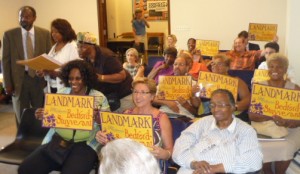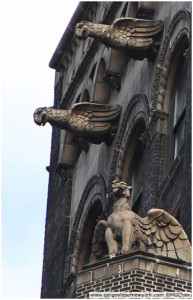“There are area owners convinced that investing in their historic buildings makes good business sense.” Real Estate Weekly
- Preservation Pays! REBNY’S Campaign Against Landmark Protection Is Misguided By Jeffrey Kroessler
- Renovation, restoration the trend in Midtown East By David V. Griffin
Preservation Pays! REBNY’S Campaign Against Landmark Protection Is Misguided
Image from the 2011 Bedford-Stuyvesant community hearing
“The goose that laid the golden eggs”. That’s how HDC board member Dr. Jeffrey Kroessler described the Landmarks Law in his recent article published in ‘The New York Observer’. Dr. Kroessler takes especial aim at the falsehoods that the Real Estate Board of New York enjoys repeating – how preservation is bad for the city, bad for the economy, and bad for New Yorkers. It’s a wonder they don’t blame landmarking for shortened life spans and juvenile delinquency. Dr. Kroessler, an urban historian, takes us on a trip through history and debunks these myths.
“Landmarking is bad for business.”
“In the 1980s, as the city staggered out of the fiscal crisis of the previous decade, the Theater District was under siege. Many legitimate theaters were dark, and in 1982 five beloved theaters, most notably the Helen Hayes and the Morosco, were demolished to make way for the 50-story Portman Hotel, now the Marriott Marquis. In response, the theatre community, civic organizations and preservationists campaigned to designate the remaining Broadway theaters. By 1987, twenty-five theaters had been designated, and the two major theater organizations sued to overturn the designations.
Can anyone imagine how impoverished the city would have been had that suit been successful? Absent landmarking, there would have been no Broadway revival because the theaters would have been gone. Today, every venue is alive, and when one show closes another is ready to take its place. The industry pumps hundreds of millions of dollars into the city and employs thousands in theatres and ancillary businesses, like the restaurants, hotels and retail stores in Times Square. Historic preservation clearly was the catalyst. And the theatre owners who fought designation … well, let’s just say their bottom line is rather healthy.”
“Landmarking makes neighborhoods unaffordable.”
“Property values have risen all across the city in recent decades, and values have risen somewhat more in historic districts. Is that a bad thing for the city? For homeowners? Only, it seems, if the property is in a historic district. Otherwise, it is the free market at work. “
“By opposing preservation, REBNY and its allies oppose the will of the people. The Landmarks Commission has designated historic districts only when a sold majority of residents are in favor.”
To read the whole article go to: http://observer.com/2014/02/preservation-pays-rebnys-campaign-against-landmark-protection-is-misguided/#ixzz2tEOSryNZ
Don’t forget to ‘like’ and ‘share’
Follow us: @newyorkobserver on Twitter | newyorkobserver on Facebook
Renovation, restoration the trend in Midtown East
Gargoyles from 285 Madison
Speaking of preservation being bad for business, remember all those claims that we had to demolish all the pretty old buildings in Midtown East because no business wanted to walk their crummy old corridors? Real Estate Weekly reports that Greg Popkin, chief operating officer of the real estate firm RFR, thinks differently:
“With an ever-more diverse tenant base seeking prestige and brandibility as well as up-to-date technology and convenience of location, Midtown East and its environs may be turning the corner from the prosaic location of recent years to the high-style destination address of its prewar-through-postwar glory days.
Greg Popkin, chief operating officer of RFR, believes that the firm’s rebuilding of 285 Madison may be at the forefront of a new trend.
“There’s a new repositioning of (Midtown East). People are developing the area as a boutique location and historic buildings are seen as a draw. Tenants are again looking for a building that has distinction.”
Popkin sees 285 Madison as “A chance to take something that was downscale and take it back it to its original level of desirability.”
Noting the unique architectural features of 285 Madison, which include humorous miniature “gargoyles” at street level, Popkin says that RFR had considered demolition but decided against it: “It would be a shame to lose a building that has so many great elements,” he said. “Our operating history proves that we embrace this kind of challenge.”
To read the full ‘Real Estate Weekly’ article click here http://www.rew-online.com/2014/02/06/renovation-restoration-the-trend-in-midtown-east/
To read more about the proposed East Midtown Rezoning click here http://hdc.org/featured/proposed-east-midtown-rezoning-post-proposed-individual-landmarks
Don’t forget to ‘like’ and ‘share’
———————————————————————————————————————————————–
Follow Us on Facebook and Find Out What’s Up in New York Preservation
HDC uses our Facebook account to circulate news articles about preservation in New York City. Check us out at https://www.facebook.com/pages/Historic-Districts-Council/91520047765.
————————————————————————
If you’re receiving this, then you know that HDC is working hard throughout the city to protect and preserve the neighborhoods which make New York great. Please consider contributing and becoming part of the movement to preserve our city’s irreplaceable architecture and history. There are a lot of buildings to cover, and we can only do it with a lot of people.
Sign up to receive our future emails.
————————————————————————
tel: 212-614-9107 fax: 212-614-9127 email: [email protected]





